In the dynamic musical terrain of the 1980s, "Once in a Lifetime" and its remarkable music video shine as symbols of creativity and introspection. They serve as living embodiments of the "happy accidents" that characterize the distinctive history surrounding their inception. This masterpiece by Talking Heads not only represents a pivotal moment in musical innovation but also leaves an enduring imprint on popular culture. It accentuates the intricate interplay between the band's creative prowess and the transformative influence of Brian Eno in the creation of the album "Remain in Light."
The origins of "Once in a Lifetime" can be traced back to the song "I Zimbra" from their previous album, "Fear of Music." Influenced by Fela Kuti's style, the band embarked on an improvisation session around this song, resulting in an additional track named "Right Start" in the 2006 reissue. Tina Weymouth's distinctive baseline lick in this improvisation became the cornerstone for the creation of "Once in a Lifetime."
Under the influence of krautrockers Can and producer Teo Macero, Brian Eno led the creative dismantling of the improvised session alongside the band. This process involved recreating the rhythm, removing instruments, and overlaying melodic and rhythmic ideas onto the pattern set by Tina's baseline. A later misinterpretation by Eno of the song's riff added a distinctive duality to the rhythmic structure, further enriching the composition.
The lyrics, masterfully crafted by David Byrne, evolved as an extension of his investigations for the solo project "My Life In The Bush Of Ghosts." Exploring recordings from various religious and political contexts, the lyrics reflect the feverish intensity present in these recordings. Sung as a sermon, they subtly critique automation and routine in modern life, highlighting how people often operate in a state of unconsciousness in their everyday existence.
According to David Byrne, the song delves into the human experience of operating largely unconsciously, living "half-awake or in autopilot." The iconic line "And you may ask yourself, well, how did I get here?" reflects the surprise and bewilderment at one's own existence, suggesting that our decisions are often driven by deeper, more automatic forces than conscious deliberation.
The philosophical message and unique energy of "Once In A Lifetime" are strikingly injected into its video, a surreal piece of art that complements the introspective nature of the song. Co-director Toni Basil contributed to the distinctive visual vision, drawing inspiration from religious rituals and exploring archives at UCLA to select footage seamlessly integrated into the video. Despite its modest budget, the video became a visual beacon in the early days of MTV, significantly contributing to the song's popularity and leaving an indelible mark on popular culture.
Since its creation, the video has inspired numerous reinterpretations, highlighting its lasting impact. A notable example is the humorous recreation of the iconic scene by Kermit the Frog from the Muppets, blending the song's extravagance with the Muppets' characteristic charm.
In summary, "Once In A Lifetime" transcends being merely a musical piece; it is an introspective journey that continues to resonate with later generations. The collaboration between Talking Heads, David Byrne, and Toni Basil, both musically and visually, has left an indelible mark on popular culture and the history of music. Its ability to transcend barriers and connect with the human experience makes it a lasting beacon of creativity and reflection, demonstrating that the most memorable moments sometimes arise in life's unique instances.
My personal reflections and additional musical recommendations.
Keep reading with a 7-day free trial
Subscribe to Boombastic to keep reading this post and get 7 days of free access to the full post archives.




